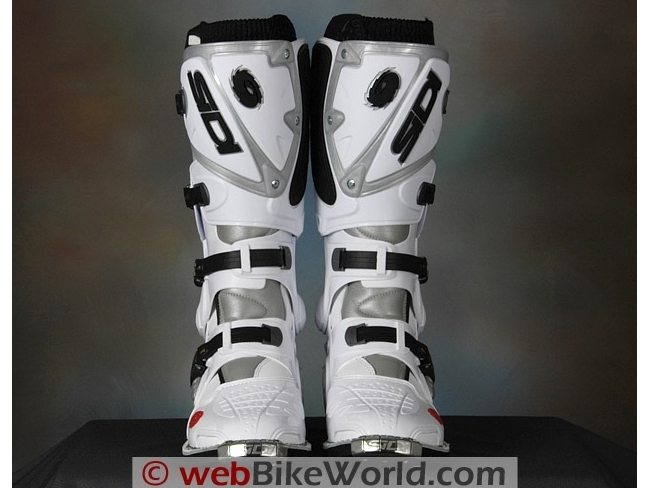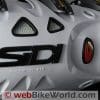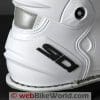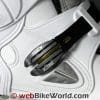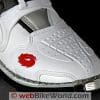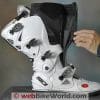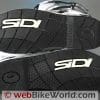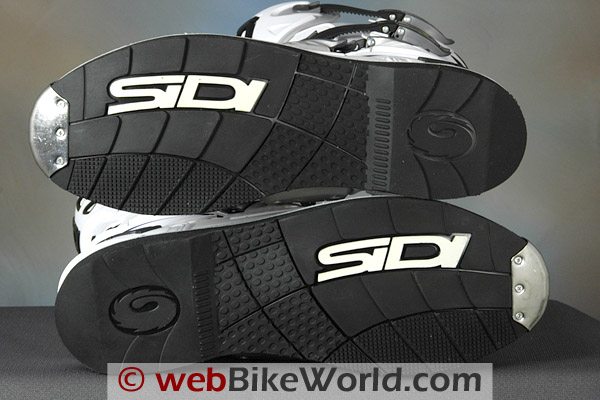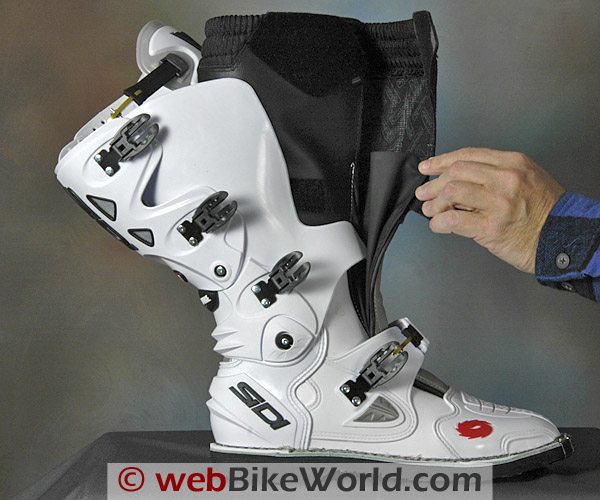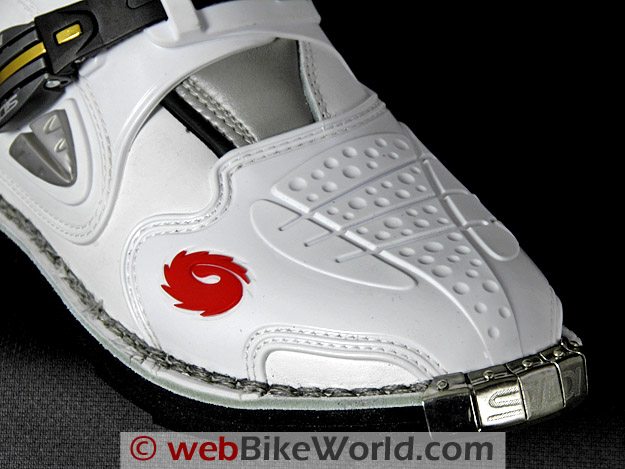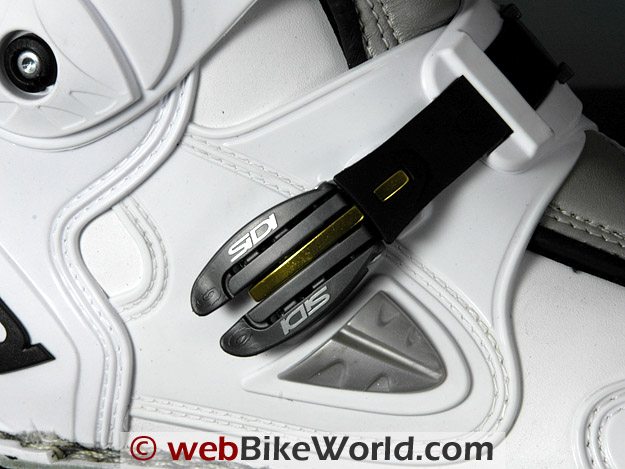A new year is upon us and notwithstanding the piles of white cold stuff outside, my first evaluation of 2010 comes up as a positive experience.
The Sidi Crossfire TA boots might represent the base motocross offering, but I am glad to say that these boots accommodate without much sacrifice.
Good off-road boots must fit well, protect well and perform well; there is much to risk if they do not.
The Sidi Crossfire TA boots deliver the goods.
Personal protective equipment (PPE) is an important requirement for motorcyclists and a good pair of boots and a good helmet, both with a comfortable fit are priority items.
Most of us have access, one way or another, to a wide range of off-road products, including footwear. There are many different choices but in this arena Sidi seems to be the dominant player (or at least one of them) and for good reason.
It is not hard to heap praise on virtually any pair of Sidi motorcycle boots, no matter the model or style.
One can reference any of the Sidi boot articles by clicking on the links in the right-hand column, and typically the first impression of a Sidi boot is quality, usually followed by functionality.
With four pair of various Sidi motorcycle boots occupying space in my front closet or stowed away downstairs in winter slumber, both riders in this household acknowledge a slight bias towards the Sidi brand and for good reason.
They are extremely hard to beat in the critical categories: form, fit and function.
I am a perfect size 46 Euro (11.5 US or 11.0 GB) but my foot is narrow. As a long time rider and consumer, it was a difficult task to find well-fitting boots, at least until discovering Sidi.
Needless to say, the offer of a pair of Sidi Crossfire TA boots was a Christmas present from the Santa-playing Editor that I couldn’t refuse.
Although originally known for producing supremely comfortable bicycling footwear, Sidi is probably now best known for their motorcycle collection of products that in addition to boots now also includes gloves, clothing, spare parts and accessories.
Not surprisingly, boots comprise the largest segment within the Sidi motorcycle collection. The Sidi Off-Road boot product line varies according to country, but in the U.S. it consists of the Crossfire TA, the Crossfire SR, the Charger and the Discovery Rain Boot (review).
The Crossfire TA (“Top Action”) and the Crossfire SR (“Sole Replacement”) are similar in most respects.
The Crossfire SR is designed for motocross or dirt track racing. It’s available in more base colors and it is reinforced front to rear and vertically, especially at the area over the foot peg.
Sidi also sells the Crossfire Supermoto,, Saber, Stinger and Trial Zero boots in other countries.
Each of these models possess distinctive features and the Crossfire TA has all of the essentials needed in a good off-road boot. And like other models in the line it has quite a few unique features and improvements over previous iterations. Sidi does not stand still.
Since first introduced in 2005 to showcase a number of unique Sidi features, including the Flex system, Sidi says that the Crossfire has been updated regularly to take advantage of technology and emerging requirements, especially from sponsored racers and a broad user base.
Features of the Sidi Crossfire Boots
Before jumping into this new pair of boots and marking up the bright white exterior, a bit of time was spent in going through the features of the boot and once received, the in-depth physical review got started in earnest.
Like most serious off-road motorcycle footwear, the Crossfire boots are quite heavy at just about 2 kg (4 lbs., 13-1/8 oz.) and for good reason.
Without going into the “Ride on Sunday, Work on Monday” explanation (also known as Limb-Saving 101), off-road boots in general need to be strong in virtually all areas but still flexible at key spots for the foot and lower leg.
As well, they must fit properly and support the rider in comfort, both on and off the machine. This latter point is often hard to accommodate without sacrificing requirements in other areas.
The full-height Crossfire boots do a very good job of meeting all requirements without much sacrifice.
Standing just over 43 cm (17 in) high, the boots cover all but about five inches of my lower leg. Between the boots and knee-pads and/or armor installed in riding pants, the lower leg is well protected under most circumstances.
A Crossfire boot, considered from the top down to the ankle pivot, is actually comprised of two layers: the stand-up boot itself and the inner lining or sheath.
This lining is actually comprised of two large flexible wrap-around multi-piece assemblies or plates held together with light screws. The plates form their protective outer sheath when secured by the Sidi cam-lock buckles and straps.
Sidi Dual Flex System
Sidi’s unique “Dual Flex System” provides two circlip points on each side of the boot; one rear-set at the midpoint of the boot and the second centered just above the ankle joint.
These points allow the inner liner assembly to be attached to the boot itself and as pivots, provide improved flexibility of the foot.
Sidi says that with the “Dual Flex System and the four floating independent straps, the Crossfire can provide each rider with a personal fit no matter his body shape or if he uses knee braces or not”.
Having suffered through more than one pair of highly protective but cast-like boots, I was more than a little intrigued by the approach. What can I say — all it took was one ride on the F800GS (review) to convince me that this feature really works.
The upper part of the boot is full grain leather with silver-colored Lorica inserts on the front tongue and the back joint to provide better flexibility and comfort.
Lorica is a leather-like microfiber material claimed to be stronger than leather while also lighter, softer and unlike many leather products, it requires little maintenance.
Something a lot of riders appreciate is an adjustable system to accommodate different calf sizes and Sidi really delivers here. The Crossfire boot and top plate uses the patented Sidi adjustable calf system that allows precise fitment of the boot around the calf.
Believe me, this is especially important for riders with larger calves and in general for all riders depending on any under or over layers being worn.
The inner boot features a top and mid flap with hook and loop fastener allowing close adjustment from above the ankle to the upper calf area.
A precise fit here also provides an excellent seal to keep the elements out.
The Crossfire is designed to fit riders with up to a 56 cm (22″) calf diameter measured at a distance of 36 cm (14″) above the bottom of their heel.
The front or shin section of the outer wraparound plate is anatomically correct and like all of the plate sections on the Crossfire boots, it is replaceable.
The inner plastic plate is made from a stiff material to support the boot and the large upper plate is a multi-part replaceable polyurethane component that wraps securely around the upper inner and front part of the boot.
The side piece has a heat resistant rubber insert to protect the leg from exhaust heat (as applicable) and to minimize wear and tear with time and use.
And if you don’t like the all-white or all-black basic colors, the Crossfire boots can be customized with an online tool at the Motonation website to replace any of the parts with colors of your choice.
Another feature so typical of Sidi but still not found on all off-road boots is the rigid nylon insert added to the inside wall of the boot for metatarsus protection.
In instances where the boot/foot slides off the foot peg, the kick starter (remember those things?) gets missed or a well-placed rock makes known its presence, this side protection can prevent or minimize damage to the metatarsal region.
Temporary or permanent damage to this area of the foot is no laughing matter, which is why it is so important to find a boot that provides direct protection like the insert or a reinforced sole edge for direct support as well.
Need I say that this small plate secured with four screws is replaceable?
The whole boot becomes a snug, secure and protective environment once the adjustable buckles are brought in to play. While somewhat different from the standard buckle fastener I see on so many other brands, the Sidi cam-locks are no less effective.
The Crossfire features four of these buckles: two on the upper plate, one on the lower or ankle pivot plate and one at the instep.
Standard for this type of boot and fastener, each buckle has a longish serrated plastic pull strap, easily adjusted from the inner side of the applicable plate. Each buckle works independently allowing the user to get the precise fit desired for comfort, flexibility and security.
As with other bootleg components, everything can be replaced.
Last, but certainly not least, on the form list is the sole and by virtue of a close relationship, the insole. The thick sole is made of anti-skid rubber with a unique pattern designed for grip, mobility and wear and fastened to the boot with heavy stitching and a sealing bond.
De rigueur for most off-road boots, a polished metal toe plate is riveted and screwed to the front edge of the sole, adding additional frontal protection and, the ability to create sparks — so impressive at speed!
Another appreciated feature of Sidi boots is the attention paid to the insole. The shaped insole in the Crossfire is reinforced for strength and features a removable arch support.
On many boots I typically take the supplied insole out and use something of my own liking, but so far, the insoles in these boots are perfect.
Sidi Crossfire Boots – Fit
Getting your feet into any motocross style boot, especially in a big boot like the Sidi Crossfire, can range from a minor exercise to a full out attack which the human might not always win.
The Crossfire at first appears to be a challenge, but only if the features of the boot are not exploited.
Like most off-road or full-height boots, the foot still needs to be at the just-right angle to make for an easy entry: the Crossfire boot simplifies this exercise considerably.
Pivot the outer plates back away from the boot itself, open the front flap wide and slip the foot in, albeit with a little effort, in to the Cambrelle-lined boot. This material is widely used and so far I have never experienced any problems with it. It always seems to do its job in wicking away moisture and reducing odors.
With the feet planted firmly inside, it is a simple matter, seated or standing, to pull the inner flap across and secure it to the outside edge of the inner boot, letting the hook n loop material do its magic. I remain impressed as to how good a fit the upper calf seal provides, without being uncomfortable in any way.
I find it easier to adjust the strap and secure the bottom or in-step buckle, after flexing the foot a few times to determine just how much play, if any, is desired.
This buckle can actually be tightened up probably more than with other boots — the two pivot points allow flex at the correct points with seemingly less strain on the instep.
The instep fastener has an extra outer layer underneath the strap as well, along with a small deflector strip to protect the strap and this area of the foot from stones, etc.
Working my way up, the above-ankle strap is next, followed by the lower and upper calf fasteners. Again, given the pivot action of the bootleg itself, I find that the boot is probably done up tighter than possible with previous pairs.
The only typical user adjustments made have been to accommodate any inner or outer pant being worn inside.
The metal catch on the strap slides down into the groove on the plastic rotating body of the buckle and the assembly rotated in towards the boot, while the eccentric pivot pressure pulls everything tight.
If some fine tuning is needed, it is an easy matter to release the assembly, take the pressure off the serrated strap and push it in or out as needed to decrease or increase its length.
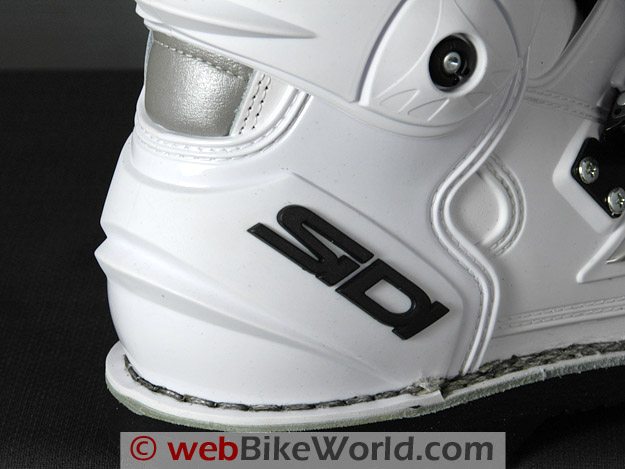

Functionality of the Sidi Crossfire TA Boots
So far, so good. The boots fit really well, something expected from Sidi, at least for my foot and the unique Dual Flex system is impressive in its design, ease of use and functionality.
I can flex my feet or change the angle of them on the pegs and still be comfortable, standing or sitting.
I don’t expect the injection-molded outer material of the Crossfire boots to “break-in” or soften up much, but that’s OK. Out of the box they have proven to be comfortable and easy to live with.
The thickness of the front boot area makes full toe shifting a bit more difficult on other than pure off-road bikes, but a (long overdue) upwards adjustment of the shift lever on the F800GS was needed anyway.
Otherwise, the edge of the boot works just fine — a gentle nudge of the shifter is sufficient for the F800GS anyway.
Although used for playing out in the Florida sand and now back in winter-land, the boots haven’t seen any prolonged heavy hazard riding yet, but that will come.
I am really looking forward to getting that bright white sheathing marked up a bit…scars if you will.
Part of the comfort zone here is that if anything breaks, most of it can be replaced quite easily. There is even a small parts kit included with the boots.
Day-to-day use is also a viable proposition, including spending time clunking around in them on sidewalks, cobblestone surfaces and deep sand, all without falling down. Again, the years of experience and attention to detail makes for a very comfortable boot
And before I forget, the boots are not identified as being water-proof or water-resistant.
But a couple of rain showers revealed their ability to withstand that moisture and the crud coming off the front of the BMW…my socks stayed dry. Some wet Spring riding will tell the real tale, although this is not an imperative issue with me for these boots.
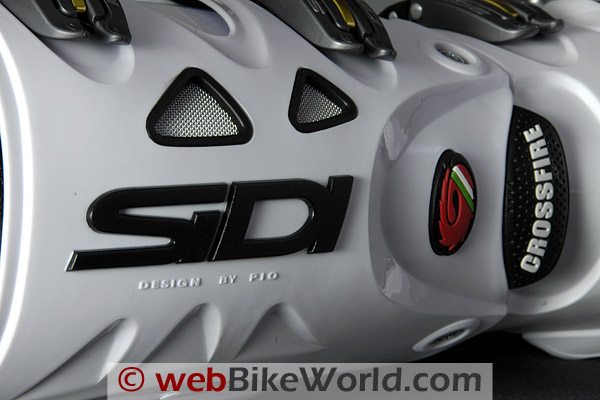

Conclusion
To say that I’m a believer would be an understatement — my assimilation to the Sidi side was voluntary a long time ago.
The two layer or sheathing approach works. Having an outer layer that is stitch-free, totally replaceable (by assembly or individual plate), and which pivots back to facilitate entry, egress or adjustment of the buckle straps is nice — really nice.
I won’t wear the Crossfire boots every day and they probably wouldn’t be my first choice for long slab trips.
But for the adventure rides and off-road forays, especially those involving riding over or bouncing off big hard things and for anything resembling a competitive ride (you know how that goes), the Crossfire boots will be on my feet.
Any premium is gladly accepted. Its hard to imagine there not being a high return on investment with boots of this caliber or practically any other Sidi boot reviewed by webBikeWorld so far.
Owner Comments and Feedback
See details on submitting comments.
From “K.F.” (March 2013): “I am currently on my second pair of Sidi Flex-Force TA boots, the predecessor to the Cross-Fire, but I feel that my observations are equally applicable to the Cross-Fire (which I have tried on and drooled over numerous times) and the recently announced Cross-Fire 2.
Mine are finally showing their age, and I am planning on picking up a pair of the CF2s this summer for next season, as I too assimilated long ago.
I have a bum ankle with very limited movement, and the fact that these boots conform so well to your leg while providing the feeling of bionic armor plating is incredible.
The hard plastic shell with the hinge system lets your ankle flex in the direction it needs to, and not in any of the other directions.
There’s no way that I could go back to a plain leather boot; they let my ankles roll all over the place in comparison, and have nowhere near the same impact protection.
That last one is an important consideration if, like I do fairly often, you ever have the misfortune of your bike ending up on your foot/leg after a crash.
Plus, if you don’t have mannequin proportioned calves, they don’t fit as snugly as the articulating joints and adjustable panels let you dial-in on the Sidis.
I also wear in-boot MX pants when riding in the desert, and one thing that I really hate is creases from the pant pressing into my leg. I have skinny calves, so the pant legs tend to bunch up inside the boot, and 20 minutes into a ride those pressure points are on fire from a lack of circulation.
One of the things that I love about this boot (besides all of the reasons listed in the review) is the fact that the outer calf shell is completely separate from the inner boot.
I put my foot in with the sock pulled all of the way up and the pant cuff above the sock, close the inner boot, fold the sock over the top of the inner boot, then pull the in-boot pants down over the inner boot as well.
I then secure the outer shell over the pants, and viola, no bunching up of the pants against my leg. The pant-leg is just as secure as being fully inside the boot, if not more so.
This method may not work for someone with large calves, but if the pants are tight enough that they can’t get them over the inner boot, they probably don’t have an issue with them bunching up anyway.
After wading around in fairly deep mud and water, I’ve found that they’re completely waterproof until the water level reaches the top of the inner liner’s “tongue” — the level of your index finger in the picture showing the outer shell tipped back — and even then it seeps in fairly slowly.
Thanks for all of the effort that goes into wBW, it’s an invaluable resource!”


